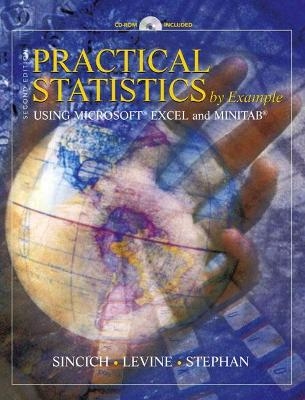
Practical Statistics by Example Using Microsoft Excel and Minitab
Prentice-Hall (Verlag)
978-0-13-041521-9 (ISBN)
- Titel ist leider vergriffen;
keine Neuauflage - Artikel merken
Microsoft Excel Primer.
MINITAB Primer.
1. Introduction: Statistics and Data.
What Is Statistics? Types of Data. Descriptive vs. Inferential Statistics. Collecting Data. Random Sampling. Other Types of Samples. Ethical Issues and Other Concerns in Statistical Applications. What Readers Need to Know about Microsoft Excel, the PHStat Add-In, and Minitab for this textbook.
2. Exploring Data with Graphs and Tables.
The Objective of Data Description. Describing a Single Qualitative Variable: Frequency Tables, Bar Graphs and Pie Charts. Describing a Single Qualitative Variable: Frequency Tables, Dot Plots, Stem-and-Leaf Displays and Histograms. Exploring the Relationship between Two Qualitative Variables: Cross-Classification Tables and Side-by-Side Bar Charts. Exploring the Relationship between Two Quantitative Variables: Scatterplots. Proper Graphical Presentation.
3. Exploring Quantitative Data with Numerical Descriptive Measures.
Objectives of Numerical Descriptive Measures. Summation Notation. Measures of Central Tendency: Mean, Median, and Mode. Measures of Variation: Range, Variance, and Standard Deviation. Interpreting the Standard Deviation. Measures of Relative Standing: Percentiles and z-scores. Methods for Detecting Outliers. A Measure of Association: Correlation. Numerical Descriptive Measures for Populations.
4. Probability: Basic Concepts.
The Role of Probability in Statistics. Experiments, Events, and The Probability of an Event. Probability Rules for Mutually Exclusive Events. The Combinatorial Rule for Counting Simple Events. Conditional Probability and Independence. The Additive and Multiplicative Laws of Probability.
5. Discrete Probability Distributions.
Random Variables. Probability Models for Discrete Random Variables. The Binomial Probability Distribution. The Poisson Probability Distribution. The Hypergeometric Probability Distribution.
6. Normal Probability Distributions.
Probability Models for Continuous Random Variables. The Normal Probability Distribution. Descriptive Methods for Assessing Normality. The Normal Approximation to the Binomial Distribution. Sampling Distributions. The Sampling Distribution of the Sample Mean and the Central Limit Theorem.
7. Estimation of Population Parameters Using Confidence Intervals: One Sample.
Point Estimators. Estimation of a Population Mean: Normal (z) Statistic. Estimation of a Population Mean: Student's (t) Statistic. Estimation of a Population Proportion. Choosing the Sample Size. Estimation of a Population Variance.
8. Testing Hypotheses about Population Parameters: One Sample.
The Relationship between Hypothesis Tests and Confidence Intervals. Hypothesis-Testing Methodology: Forming Hypotheses. Hypothesis-Testing Methodology: Test Statistics and Rejection Regions. Guidelines for Determining the Target Parameter. Testing a Population Mean. Reporting Test Results: p-Values. Testing a Population Proportion. Testing a Population Variance. Testing Category Probabilities for a Qualitative Variable. Potential Hypothesis-Testing Pitfalls and Ethical Issues.
9. Inferences about Population Parameters: Two Samples.
Determining the Target Parameter. Comparing Two Population Means: Independent Samples. Comparing Two Population Means: Matched Pairs. Comparing Two Population Proportions: Independent Samples. Comparing Two Population Proportions: Contingency Tables. Comparing Two Population Variances. A Nonparametric Test for Comparing Two Populations: Independent Samples. A Nonparametric Test for Comparing Two Populations: Matched Pairs.
10. Regression Analysis.
Introduction to Regression Models. The Straight-Line Model Simple Linear Regression. Estimating and Interpreting the Model Parameters. Model Assumptions. Measuring Variability around the Least Squares. Inferences about the Slope. Inferences about the Correlation Coefficient. The Coefficient of Determination. Using the Model for Estimation and Prediction. Computations in Simple Linear Regression. Residual Analysis: Checking the Assumptions. Multiple Regression Models. A Nonparametric Test for Rank Correlation. Pitfalls in Regression and Ethical Issues.
11. Analysis of Variance.
Experimental Design. ANOVA Fundamentals. Completely Randomized Designs: One-Way ANOVA. Follow-Up Analysis: Multiple Comparisons of Means. Factorial Designs: Two-Way ANOVA. Checking ANOVA Assumptions. A Nonparametric Test for Comparing Populations: Independent Samples.
Appendix A: Review of Arithmetic and Algebra.
Appendix B: Statistical Tables.
Appendix C: Documentation for CD-ROM Data Files.
Appendix D: Microsoft Excel Configuration and Customization.
Appendix E: More about Phstat2.
| Erscheint lt. Verlag | 19.12.2007 |
|---|---|
| Verlagsort | Harlow |
| Sprache | englisch |
| Maße | 202 x 254 mm |
| Gewicht | 1442 g |
| Themenwelt | Informatik ► Office Programme ► Excel |
| Mathematik / Informatik ► Mathematik ► Statistik | |
| ISBN-10 | 0-13-041521-9 / 0130415219 |
| ISBN-13 | 978-0-13-041521-9 / 9780130415219 |
| Zustand | Neuware |
| Haben Sie eine Frage zum Produkt? |
aus dem Bereich


